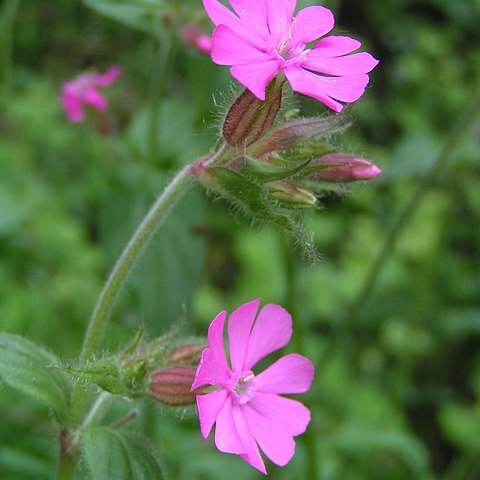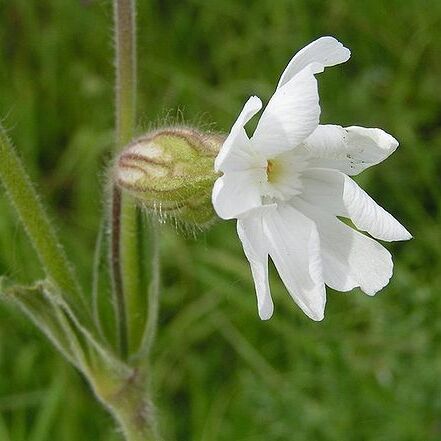Herbs, annual or perennial , rarely (not in Australia) herbaceous scrambling vines or small shrubs; non-succulent (usually), or succulent; anthocyanin pigments produced but not betalains; pinitol and triterpenoid saponins often accumulated, also carbohydrate as the trisaccharide lychnose, unique to the family. Stems usually swollen at nodes. Leaves simple, entire, opposite, rarely alternate or whorled; stipules present or absent; bases often connate or perfoliate. Inflorescence usually terminal, usually a dichasial or, occasionally, partially monochasial cyme, or rarely flowers solitary. Flowers actinomorphic, usually bisexual, rarely unisexual and then species dioecious; generally ± 5-merous. Perianth with distinct calyx and corolla, or sepaline (occasionally apetalous); (8–) 10, or 5; 2-whorled, or rarely 1-whorled. Sepals 4–5, imbricate, free or connate into a short calyx tube, usually with an internal nectary ring. Petals (0–4)–5, usually free (forming a tube in some species of Polycarpaea), often small and bifid or deeply divided, or fringed, or entire. Stamens (1–) 5, 8 or 10, variously hypogynous to subperigynous; filaments free or basally adnate to petals or sepals; anthers dehiscing by longitudinal slits; introrse; tetrasporangiate. Gynoecium 2–5 carpelled. Ovary superior, often with gynophore, syncarpous, with 2–5 carpels, unilocular at least above; style free or ±united; stigmas 2–5; free to partially joined; apical, dry; papillate. Ovules usually numerous, sometimes few or solitary; placentation basal or free-central. Fruit usually a capsule, with apical valves as many or twice as many as styles, or an achene or indehiscent nutlet, rarely (not in Australia) a berry. Seed usually with an eccentric embryo, curved or less often nearly straight, with abundant hard or soft, starchy perisperm; true endosperm usually absent.
Herbs annual or perennial, rarely subshrubs or shrubs. Stems and branches usually swollen at nodes. Leaves opposite, decussate, rarely alternate or verticillate, simple, entire, usually connate at base; stipules scarious, bristly, or often absent. Inflorescence of cymes or cymose panicles, rarely flowers solitary or few in racemes, capitula, pseudoverticillasters, or umbels. Flowers actinomorphic, bisexual, rarely unisexual, occasionally cleistogamous. Sepals (4 or)5, free, imbricate, or connate into a tube, leaflike or scarious, persistent, sometimes bracteate below calyx. Petals (4 or)5, rarely absent, free, often comprising claw and limb; limb entire or split, usually with coronal scales at juncture of claw and limb. Stamens (2--)5--10, in 1 or 2 series. Pistil 1; carpels 2--5, united into a compound ovary. Ovary superior, 1-loculed or basally imperfectly 2--5-loculed. Gynophore present or absent. Placentation free, central, rarely basal; ovules (1 or) few or numerous, campylotropous. Styles (1 or)2--5, sometimes united at base. Fruit usually a capsule, with pericarp crustaceous, scarious, or papery, dehiscing by teeth or valves 1 or 2 × as many as styles, rarely berrylike with irregular dehiscence or an achene. Seeds 1 to numerous, reniform, ovoid, or rarely dorsiventrally compressed, abaxially grooved, blunt, or sharply pointed, rarely fimbriate-pectinate; testa granular, striate or tuberculate, rarely smooth or spongy; embryo strongly curved and surrounding perisperm or straight but eccentric; perisperm mealy.
Herbs (annual or perennial) or subshrubs, rarely shrubs. Leaves simple, opposite or rarely spiral, with or without stipules. Inflorescences cymose, often loosely dichasial but sometimes secund or compact, frequently many-flowered but by reduction few-flowered or flowers solitary. Flowers, with few exceptions, actinomorphic, hermaphrodite or unisexual (the species then dioecious, monoecious, or polygamous), parts in fives or rarely in fours, perianth hypogynous or perigynous, often with an internode between the calyx and the corolla. Calyx of free sepals (polysepalous) or gamosepalous, frequently persistent and becoming more or less scarious. Corolla of free petals, in the gamosepalous genera with usually well differentiated lamina and claw and corona of scales often present, in the polysepalous genera not so differentiated, entire to deeply bi-lobed, sometimes absent. Stamens 5 + 5 or fewer by reduction. Gynoecium of 2, 3, 4, or 5 carpels, syncarpous; ovary 2-, 3-, 4-, or 5-locular or unilocular, with numerous, few, or solitary ovules with axile, central, free central, or basal placentation. Fruits capsular or reduced to one-seeded indehiscent nutlets. Seeds with perisperm but no, or at most very little, endosperm; embryo most often curved
Petals free, in the gamosepalous genera usually with well-differentiated lamina and claw and coronal scales often present, in the polysepalous genera less differentiated and entire to more or less deeply bifid, sometimes absent
Ovary superior, sessile or shortly stalked, 1-locular or incompletely or more rarely completely divided into 2–5 loculi; ovules 2-many with axile, central, free-central or basal placentation
Flowers actinomorphic (at least in our genera), bisexual or unisexual, 5-merous or rarely 4-merous, perianth hypogynous or perigynous, often with an anthophore between the calyx and corolla
Ovary superior, sessile or shortly stipitate, 1-celled or imperfectly divided at the base, with free-central placentation; styles free or variously connate; ovules mostly numerous
Herbs, annual or perennial; leaves opposite, simple, often connected at the base by a transverse line; stipules absent or if present often scarious
Stamens up to 10, free from one another or slightly united at the base; anthers 2-celled, dehiscing longitudinally
Inflorescence cymose, often loosely dichasial but occasionally secund or capitate, rarely flowers solitary
Sepals free or calyx gamosepalous, often persistent and frequently more or less scarious
Seeds with endosperm and a more or less curved peripheral or excentric embryo
Sepals free or united into a tube, imbricate, often with membranous margins
Leaves opposite, often arranged in false whorls; stipules present or absent
Flowers actinomorphic, mostly hermaphrodite, solitary or in cymes
Petals as many as the sepals, often small or absent
Capsule opening by valves or apical teeth
Annual or perennial herbs or shrublets
Stamens 5 + 5 or fewer by reduction
Fruit capsular


